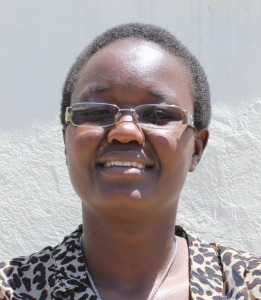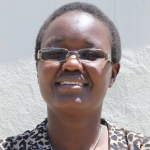"Mukunga Spring has a lot of water; the only challenge is that the water is not clean because the spring is not protected. I will be so grateful if the spring will be protected because my children will be safe and healthy," said Mrs. Esther Omulindi, a 35-year-old farmer and mother living in Mwera Community.
Esther is 1 of 200 people who depend on Mukunga Spring for all of their daily water needs, but every day the spring puts their health and general wellbeing at risk.
At Mukunga Spring, water fetching times stretch throughout the entire day which is not desirable. Community members must come to Mukunga Spring early in the morning, during lunch hours, and in the evening to try to avoid the queues and give the water some time to settle between people. But with the slow process of scooping water with a small jug and then pouring it into larger jerrycans, wait times are almost always guaranteed.
Overcrowding at the spring often leads to conflicts among women and children in the community since they are predominantly the ones responsible for fetching water in each family. While each person scoops water as quickly yet carefully as they can, the process is time-consuming and mud inevitably gets churned up in the water. Everyone just wants to fetch the cleanest water possible so they can get on with the rest of their day. Community members find they spend more time at the spring than anywhere else, reducing the number of hours they can work.
Mukunga spring hosts a number of contaminants: algae, water plants, bugs, and rotting leaves are constant companions in the water. Surface runoff from the rains carry soil, farm chemicals, and animal waste into the water, and the scoop-pour method adds any dirt or bacteria from people's jugs into the water. As much as they try not to touch the water, shoes, feet, and hands often dip into the water as well.
Many households here who depend on Mukunga Spring report frequent cases of stomachaches, diarrhea, typhoid, and coughing, especially in children and the elderly. People believe thier water-related diseases orginate in Mukunga Spring's water because, when they visit the hospital, they are always told to use clean water for consumption. But without another water source nearby, people are forced to continue using Mukunga Spring's water regardless of what it costs them in finances spent on medical care and the time and energy lost from work.
The access point at the spring is quite difficult to use. Adults and children alike try to perch on a few small stones while reaching their containers away from the shallowest water, lest they collect sand in their jugs. The strained reach is an awkward pose to maintain and repeat, and children often fall in as a result.
"I will be happy to fetch water from the pipe instead of using a scooping jug which is too heavy for me," said a very young Joy, who has to help her mother fetch water every day.
What We Can Do:
Spring Protection
Protecting the spring will help provide access to cleaner and safer water and reduce the time people have to spend to fetch it. Construction will keep surface runoff and other contaminants out of the water. With the community’s high involvement in the process, there should be a good sense of responsibility and ownership for the new clean water source.
Fetching water is a task predominantly carried out by women and young girls. Protecting the spring and offering training and support will, therefore, help empower the female members of the community by freeing up more of their time and energy to engage and invest in income-generating activities and their education.
Training on Health, Hygiene, COVID-19, and More
To hold trainings during the pandemic, we work closely with both community leaders and the local government to approve small groups to attend training. We ask community leaders to invite a select yet representative group of people to attend training who will then act as ambassadors to the rest of the community to share what they learn. We also communicate our expectations of physical distancing and wearing masks for all who choose to attend.
The training will focus on improved hygiene, health, and sanitation habits in this community. We will also have a dedicated session on COVID-19 symptoms, transmission routes, and prevention best practices.
With the community’s input, we will identify key leverage points where they can alter their practices at the personal, household, and community levels to affect change. This training will help to ensure participants have the knowledge they need about healthy practices and their importance to make the most of their water point as soon as water is flowing.
Our team of facilitators will use a variety of methods to train community members. Some of these methods include participatory hygiene and sanitation transformation, asset-based community development, group discussions, handouts, and demonstrations at the spring.
One of the most important issues we plan to cover is the handling, storage, and treatment of water. Having a clean water source will be extremely helpful, but it is useless if water gets contaminated by the time it is consumed. We and the community strongly believe that all of these components will work together to improve living standards here, which will help to unlock the potential for these community members to live better, healthier lives.
We will then conduct a small series of follow-up trainings before transitioning to our regularly scheduled support visits throughout the year.
Training will result in the formation of a water user committee, elected by their peers, that will oversee the operations and maintenance of the spring. The committee will enforce proper behavior around the spring and delegate tasks that will help preserve the site, such as building a fence and digging proper drainage channels. The fence will keep out destructive animals and unwanted waste, and the drainage will keep the area’s mosquito population at a minimum.

 Protected Spring
Protected Spring
 Rehabilitation Project
Rehabilitation Project



































